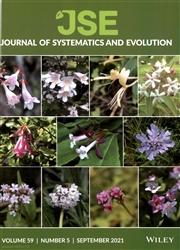Biogeographic analysis based on phylogenomic data supports multiple ancient dispersals that facilitated the eastern Asia–North America–Mexico disjunction in the subfamily Linnaeoideae (Caprifoliaceae)
IF 2.9
1区 生物学
Q1 Agricultural and Biological Sciences
引用次数: 0
Abstract
The small subfamily Linnaeoideae of Caprifoliaceae exhibits a disjunct distribution in Eurasia and North America, including Mexico, with most taxa occurring in eastern Asia or Mexico and the monospecific Linnaea Gronov. ex L. having a circumboreal to north temperate distribution. We sampled 17 of the 20 species representing all Linnaeoideae genera and used nuclear (target enrichment) and complete plastome sequence data to reconstruct the phylogeny. Our results show strong topological conflicts between nuclear and plastid data, especially concerning Dipelta Maxim. and Diabelia Landrein, supporting hybridization events complicating the deep diversification. Nuclear data were used for divergence time estimation and ancestral area reconstruction. The divergence time between the Mexican Vesalea M. Martens & Galeotti and the Linnaea clade was dated to 39.5 Ma, with a 95% highest posterior density of 28.2 Ma (mid‐Oligocene) to 45.2 Ma (mid‐Eocene). Reconstructed ancestral areas support a widespread common ancestor of Linnaea plus Vesalea in Mexico and at least another area (eastern Asia, North America, or Europe). The biogeographic analysis, including fossils, supports the ancestral range of Linnaeoideae to be widespread in central and western China + Europe + Mexico, or eastern and northern Asia + central and western China + Mexico, or central and western China + North America + Mexico. The North Atlantic and/or the Bering land bridges may be important in the widespread distribution across continents in the Northern Hemisphere. Our study highlights the importance of utilizing fossils in biogeographic inferences andusing data from different genomes while reconstructing deep and shallow phylogenies of organisms.

基于系统发生组数据的生物地理分析表明,亚洲东部-北美洲-墨西哥之间的分界是由古代的多次扩散促成的。
毛果芸香科 Linnaeoideae 小亚科在欧亚大陆和北美洲(包括墨西哥)分布不均,大多数类群分布在亚洲东部或墨西哥,而单种的 Linnaea Gronov.我们从 20 个物种中抽取了 17 个物种,代表了所有 Linnaeoideae 属,并利用核序列(目标富集)和完整质体序列数据重建了系统发生。我们的结果表明,核数据与质粒数据之间存在强烈的拓扑冲突,尤其是在 Dipelta Maxim.核数据被用来估计分化时间和重建祖先区域。墨西哥 Vesalea M. Martens & Galeotti 与 Linnaea 支系的分化时间为 39.5 Ma,95% 的最高后验密度为 28.2 Ma(更新世中期)至 45.2 Ma(始新世中期)。重建的祖先区域支持在墨西哥和至少另一个地区(亚洲东部、北美洲或欧洲)广泛分布的菱形亚纲和灶神草亚纲的共同祖先。包括化石在内的生物地理分析表明,麒麟菜科(Linnaeoideae)的祖先广泛分布于中国中西部 + 欧洲 + 墨西哥,或亚洲东部和北部 + 中国中西部 + 墨西哥,或中国中西部 + 北美洲 + 墨西哥。北大西洋和/或白令陆桥可能是北半球各大洲广泛分布的重要原因。我们的研究强调了在生物地理推断中利用化石的重要性,以及在重建生物深层和浅层系统发生时利用不同基因组数据的重要性。
本文章由计算机程序翻译,如有差异,请以英文原文为准。
求助全文
约1分钟内获得全文
求助全文
来源期刊

Journal of Systematics and Evolution
Agricultural and Biological Sciences-Ecology, Evolution, Behavior and Systematics
CiteScore
7.40
自引率
8.10%
发文量
1368
审稿时长
6-12 weeks
期刊介绍:
Journal of Systematics and Evolution (JSE, since 2008; formerly Acta Phytotaxonomica Sinica) is a plant-based international journal newly dedicated to the description and understanding of the biological diversity. It covers: description of new taxa, monographic revision, phylogenetics, molecular evolution and genome evolution, evolutionary developmental biology, evolutionary ecology, population biology, conservation biology, biogeography, paleobiology, evolutionary theories, and related subjects.
 求助内容:
求助内容: 应助结果提醒方式:
应助结果提醒方式:


